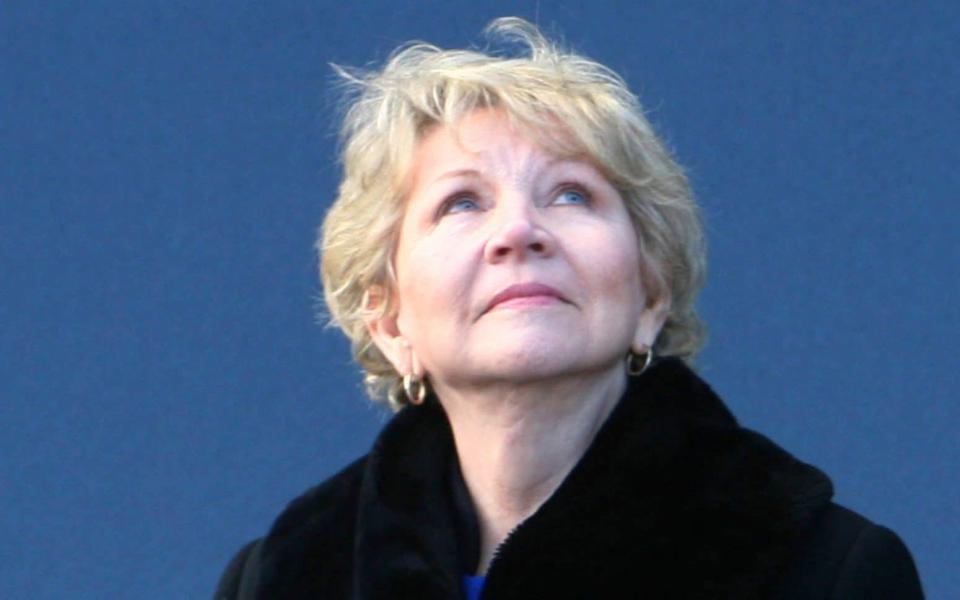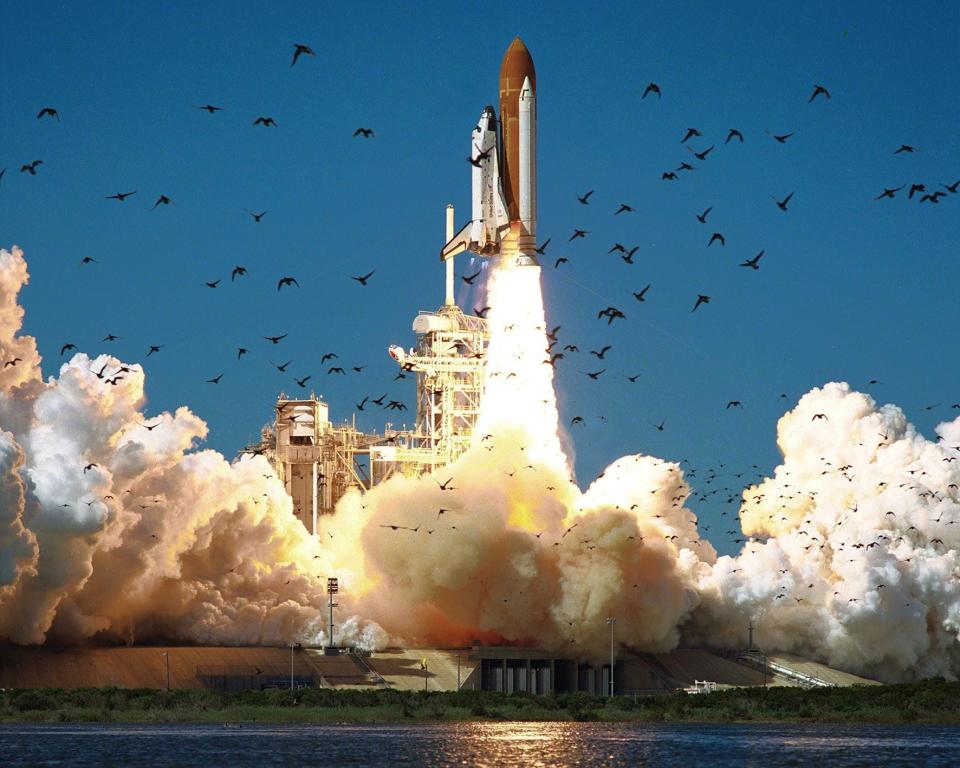June Scobee Rodgers: 'my late husband had misgivings about Challenger's launch'

It is the Valentine’s card that stands out in June Scobee Rodgers’ memory. It was January 28 1986, and she and her two teenage children had just been hurried away by NASA officials from the launchpad in Cape Canaveral after seeing the Challenger space shuttle explode in mid-air shortly after take-off. Her husband, Dick Scobee, was commander of its seven-strong crew.
Some of the families of other crew members – including loved ones of Christa McAuliffe, who had emerged from a national competition to become the first schoolteacher sent into space – were still clinging to the hope that there would be survivors. But June’s worst fears were confirmed when, on a nearby TV, she heard a reporter saying such chances were likely zero.
She escaped into Dick’s room in the crew quarters to cry in private. “I hugged the clothes in his closet and opened his briefcase. On top of the manilla military folders was a Valentine’s card for me. He was expecting to be back in seven days in time to give it to me. In the middle of everything before the launch, he had prepared it. That was just another part of his love for me.”
Her voice is strong and her gaze firm as she speaks from her book-lined home in Chattanooga, Tennessee. But when she finishes, this 78-year-old grandmother of six reaches her fingers up to dry the corners of her eyes.
A new four-part Netflix documentary series, Challenger: The Final Flight, sees June talk on screen about that day – though both there, and in our interview, she requests not to be asked to recall the trauma of how it felt to watch the shuttle with her husband inside it explode in the sky above.
What is re-examined in the series is the cause of the disaster – the decision by NASA to go ahead with the launch despite icy conditions that morning, and how they might have exacerbated existing concerns about ‘O’ ring seals in the solid rocket boosters that powered the shuttle into orbit. It was their failure that day that caused the explosion.
“Watching the series,” says June, who married a 19-year-old Scobee when she was 17, “I was two persons. The first time I was reliving it, and it was extremely sad and difficult. But then I went back and watched it a second time, and I was watching history.”

Pre-launch misgivings
Did her late husband – a 46-year-old air force veteran of the Vietnam War and test pilot before he became an astronaut – have concerns?
“The night before he had misgivings about them going. He said to tell all our friends and family [who had gathered at Cape Canaveral] to go on home because the cold temperatures meant it would be several days before they could launch.”
The next morning he called her to say it was all on. When June questioned why, he said: “They’ve told us it is safe. They’ve knocked off the icicles [on the shuttle’s body] and there won’t be a problem.” But he did not mention the ‘O’ rings.
Had he ever mentioned them? The documentary makes it clear that senior figures on the space shuttle programme had acute concerns about them, but were overruled at a high-level NASA meeting on the morning of the launch.
The Rogers Commission, appointed by President Ronald Reagan to investigate the accident, reported that a potentially fatal flaw in the ‘O’ rings had first been identified in 1977. It also found that NASA’s culture and decision-making processes had played a significant role in the disaster.

Anger and forgiveness
“There was anger,” June reflects on hearing that verdict, “and a period of forgiving the people who made some tough decisions that day, not so much calculated as foolhardy risks. I just wish they would have said that they were sorry for that decision. But we’ve moved on.”
June and Dick had talked “seriously about death, and our children, who were 12 or 13 at the time. He said: ‘I could die on the Interstate in a freak accident and not contribute to my country as much as I would if I did this.’ There were many times after he died that I wished I had said, ‘don’t go,’ but I didn’t.”
Dick did, however, follow June’s advice on one matter: going to Washington to speak to those on the shortlist to be the teacher-astronaut on the mission in order to spell out the exact risks they would be taking, because he feared they were being misled by the huge public relations hype driving the mission. “He told them that Challenger was not a commercial airplane, but a spacecraft still in the testing phase.”
He sounds, I say, like a thoroughly decent human being. June’s face breaks out into a warm, wide grin. “We grew up together. It was a joyful time. And seeing the documentary, seeing these beautiful snippets of my husband when he was so happy, was joyful. So the sorrow is balanced with the 26 years that was given to me to be with this man.”
For their grieving to be so public in the aftermath of the disaster was, she says, traumatic for her and their children, Kathie and Rich. “Our children had never lost even a grandparent or a favourite pet,” she explains. “You couldn’t turn on the television without seeing pictures of the explosion.”
Kathie, now a teacher like her mother (Rich has followed his dad and gone on to be a three-star general in the US air force), complained at the time that her father “was dying a hundred times a day on TV”. For June, though, the shock came in waves – like one day, when buying groceries, picking up a jar of Dick’s beloved peanut butter before the reality set in. “I sat down in the aisle and started crying,” she remembers. She was unable to speak to reporters who called, even if she wanted to: “physically I was frozen in time. I couldn’t think.”
What saved her, she says, was to make something creative out of her grief. She set to work with the other families to build the Challenger Centers, a network of facilities mostly in the United States, where 5.5 million youngsters have thus far immersed themselves in space-themed activities, so as to develop their interest in science subjects.
It has been June’s own mission as an educator, and she remains on its board of directors. It is also her refuge when each January 28 comes around, because “Dick Scobee would not want me to cry at his headstone.”
I am curious as to why she always refers to her late husband by his full name, Dick Scobee. “I say that,” she laughs, “because I have had the joy of having a second love in my life. So I try to keep them separate in my stories.”
In 1989, at an early morning Easter service at Arlington National Cemetery, America’s hallowed ground for its fallen where her husband is buried, she met Don Rodgers, a Lieutenant General in the US Army. He was there grieving the loss of his wife to cancer.
“We understood each other immediately about our losses and became friends,” recalls June. “My children adored him. I adored his son, who now adores me too. But when Don Rodgers proposed to me, I told him I will never stop loving Dick Scobee.”
Challenger: The Final Flight is available on Netflix now
What the producer saw
Glen Zipper, executive producer of Challenger: The Final Flight, recalls the day of the disaster
On January 28 1986, a 12-year-old Glen Zipper was in school in New Jersey when a teacher interrupted his algebra lesson. Pupils were sent to the cafeteria, where they were shown footage from the launch of the Challenger space shuttle, which had exploded into a huge fireball a few minutes earlier.
Zipper says watching the news on that icy morning left an “indelible mark” on the memories of his fellow American schoolchildren. It is thought that one in six Americans watched the catastrophe live, and 85 per cent had seen footage within an hour.
“It brought us together in the immediate aftermath, in the same way as 9/11,” Zipper remembers. “But once the initial shock wore off, I also think there was a touch of cynicism. Generation X – my generation – is a cynical bunch, and I believe the seeds of that cynicism were planted in the Challenger disaster.”
Zipper has always considered Challenger to be a failure of organisational groupthink, but he was keen for the film to remind viewers of the human tragedy that lay behind it all. He was particularly touched to meet June Scobee Rodgers and Peter Billingsey, a former Hollywood child actor who was standing in the Florida crowds on the morning of the disaster, and gave an “incredibly emotional” interview about its psychological impact.
“They were all remarkable human beings,” Zipper says of the astronauts, “and they had dreams for the rest of their lives that could not be realised.”
As told to Luke Mintz

